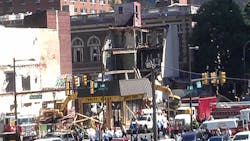Fatal Building Collapse Results in OSHA Citations – and Potential Criminal Case – for Philadelphia Contractors
An OSHA investigation has determined that two demolition contractors – Griffin Campbell, doing business as Campbell Construction, and Sean Benschop, doing business as S&R Contracting – allegedly ignored both OSHA standards and industry best practices when they removed support for a four-story wall that later collapsed onto a Salvation Army store in Philadelphia on June 5, killing six people and injuring 14.
“We should not be here today,” said Assistant Secretary of Labor for Occupational Safety and Health Dr. David Michaels during a call to update the press about the case. “If the two employers cited … had followed very basic and obvious safety precautions, six people who lost their lives on June 5, 2013 would be alive today.”
Following an investigation, OSHA on Nov. 14 cited Campbell and Benschop for safety violations, including three willful per-instance violations. Campbell Construction was demolishing the four-story building known as the “Hoagie City” building adjacent to the Salvation Army Thrift Store, located at the 2100 block of Market Street in Philadelphia. S&R Contracting was operating the building’s interior walls and floors.
“Campbell Construction and S&R Contracting sacrificed worker and public safety through the deliberate neglect of demolition safety fundamentals,” said Michaels. “This tragic incident could and should have been prevented.”
OSHA found several violations of OSHA’s demolition construction standards and, as noted by Michaels, “standard industry practice,” during the agency’s investigation of the collapse. Three days before the collapse, Campbell Construction allegedly removed critical structural supports for the wall that collapsed. The OSHA demolition standards prohibit the removal of lateral support walls more than one story high; the action allegedly taken by Campbell Construction left the wall unsupported for three days (each day resulted in a willful, per-instance citation).
Campbell Construction also allegedly removed parts of the lower floors prior to the removal of the upper floors; again, contrary to the OSHA standards and industry practice. Campbell Construction also allegedly failed to provide an engineering survey as promised.
As a result of these alleged violations of standards, Campbell Construction has been cited for three willful, egregious violations for each day that it left the wall without sufficient lateral support, and two willful violations alleging the failures to demolish the building from the top down and to have an engineering survey by a competent person on the possibility of collapse prior to starting the demolition.
When asked if criminal charges were a possibility in the case, Michaels responded, “Whenever there’s a fatality, we begin discussions with the Department of Justice.” A willful violation of OSHA law is a misdemeanor for a corporate entity, according to Michaels, who called OSHA’s criminal penalties “weak” but noted that prosecutors for the the state and county where the incident occurred have the ability to potentially file felony criminal charges against the principals of the company.
Additionally, Campbell Construction was cited for serious violations for the company’s alleged failures to provide: employees with hard hats when there was a possible risk of head injury; fall protection for employees working on surfaces at least six feet high; training on fall hazards; and adequate personal fall arrest systems. Campbell Construction also allegedly failed to inspect all stairs periodically and to maintain them in a clean, safe condition.
S&R Contracting was cited for one willful violation for allowing wall sections more than one story in height to stand alone without lateral bracing. A willful violation is one committed with intentional, knowing or voluntary disregard for the law's requirements, or with plain indifference to worker safety and health.
S&R Contracting also was cited for two serious violations for allegedly failing to protect employees from falling through holes and for allegedly failing to provide fall hazard training. A serious violation occurs when there is substantial probability that death or serious physical harm could result from a hazard about which the employer knew or should have known if an accident were to occur.
OSHA proposed penalties of $313,000 for Campbell Construction and $84,000 for S&R Contracting. When asked about the size of the fines considering the death toll following the collapse, Michaels commented that the fines reflect “the limited ability of OSHA to issues fines … Other agencies have far larger penalty structures.”
He also said the agency doesn’t issue fines because people died, but because employers violated OSHA standards or failed to provide safe working conditions for employees.
Area Director Domenick Salvatore said his office and Philadelphia’s Department of Licenses and Inspections are launching an intra-agency effort related to construction safety, since that city office issues building permits, licenses contractors and inspects construction projects. The thought is that the two agencies would share information regarding construction site safety.
Noting that while many demolition contractors follow both OSHA and industry practices, Michaels added that demolition can be a high risk undertaking said that OSHA in the past year has investigated 534 demolition operations across the country and that 25 of them involved fatalities or the hospitalization of three or more workers.
Both companies have 15 business days from receipt of the citations to comply, request an informal conference with Salvatore or contest the citations and proposed penalties before the independent Occupational Safety and Health Review Commission.
Salvatore said that there are additional investigations underway that are related to the June 5 incident.
About the Author

Sandy Smith
Sandy Smith is the former content director of EHS Today, and is currently the EHSQ content & community lead at Intelex Technologies Inc. She has written about occupational safety and health and environmental issues since 1990.
